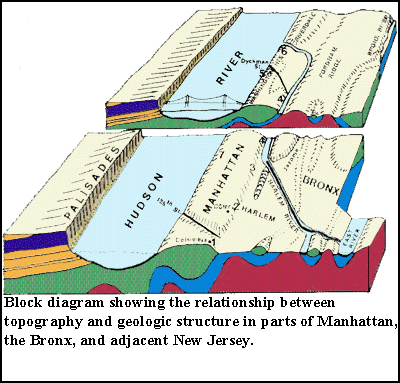| THE HYPOTHESIS: The crust of the earth in the NYC region has been subject to forces that compressed or stretched it. These forces caused the surface of the earth to be locally uplifted or depressed relative to adjacent areas. The hills and valleys of the NYC region are the result of this local uplift and depression.
THE PREDICTION: If the hypothesis is correct for landforms of the NY City region, then certain predictions may be made.
What you need to do:
- Make sure you understand the process of uplift and depression and its effects upon rocks and the surface of the
earth.
- Make a prediction as to what characteristic features should be able to be observed in the NYC region if the hills and valleys originated through uplift and/or depression.
- See whether the prediction is fulfilled. If the prediction is fulfilled, then the hypothesis is supported and strengthened. If the prediction is not bourne out, then the hypothesis is contradicted and weakened.
HINTS:
- Carefully examine the two diagrams shown on the right and review the process of uplift and depression 'rollover'. You may wish to switch back and forth between the 'rollover' and the two diagrams. You may do this by clicking on the grey button below marked 'Uplift & Depression' and the grey button in the 'rollover' that is labeled 'Back to Testing the Hypothesis'.
WHAT YOU NEED TO HAND IN:
- Place your name, class and the date at the top of a sheet of paper.
- Write the heading: "TEST OF THE HYPOTHESIS OF UPLIFT AND DEPRESSION"
- Briefly state the hypothesis you are testing.
- Clearly state your prediction.
- Explain how the prediction is a test of the hypothesis.
- State whether or not the the prediction is fulfilled.
- Give evidence to support your answer to (6).
|
 |